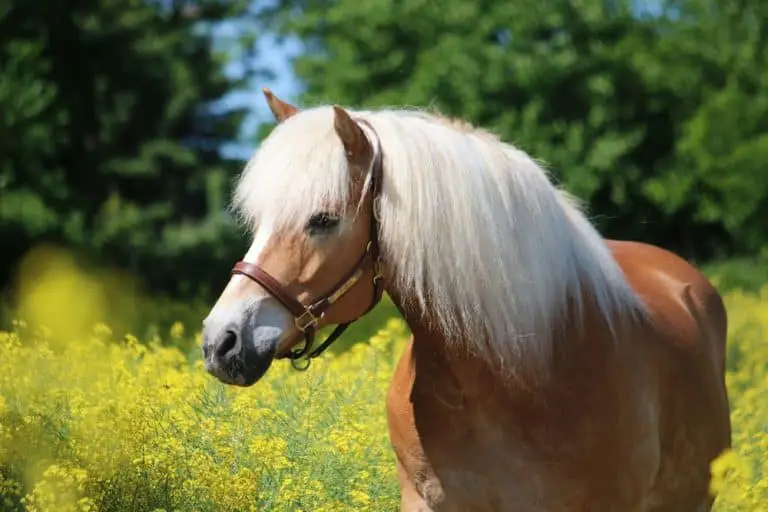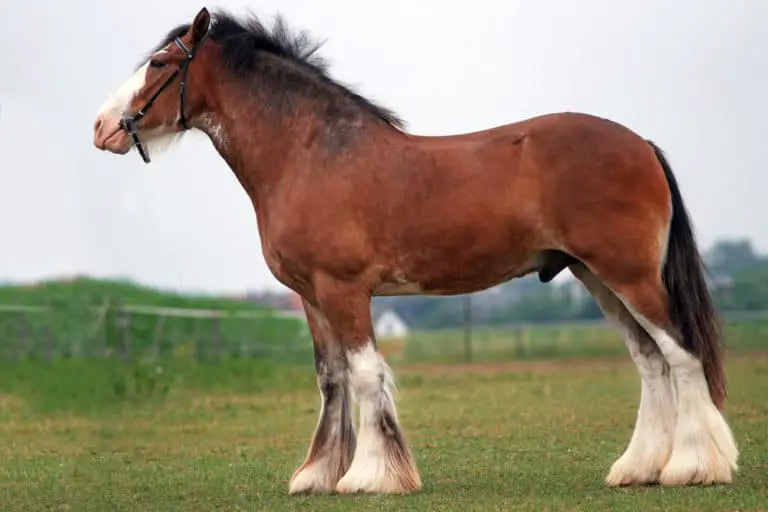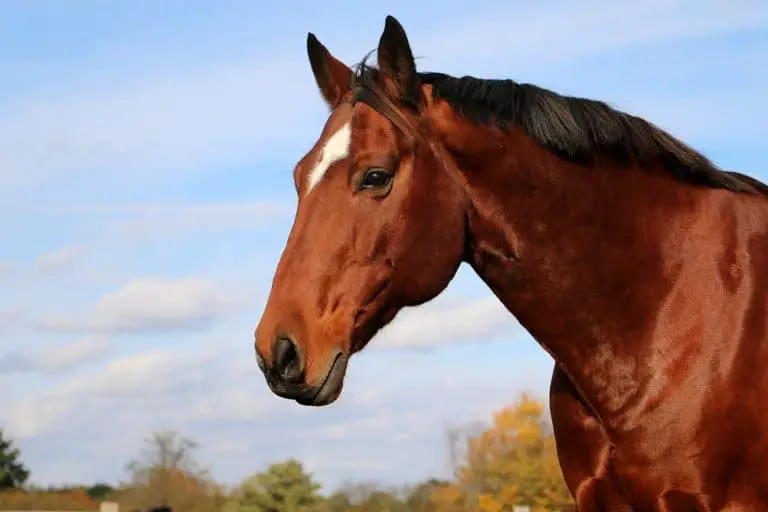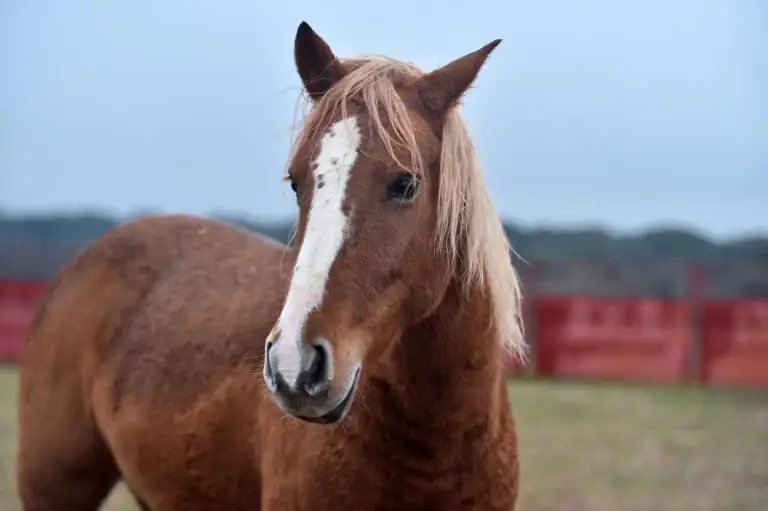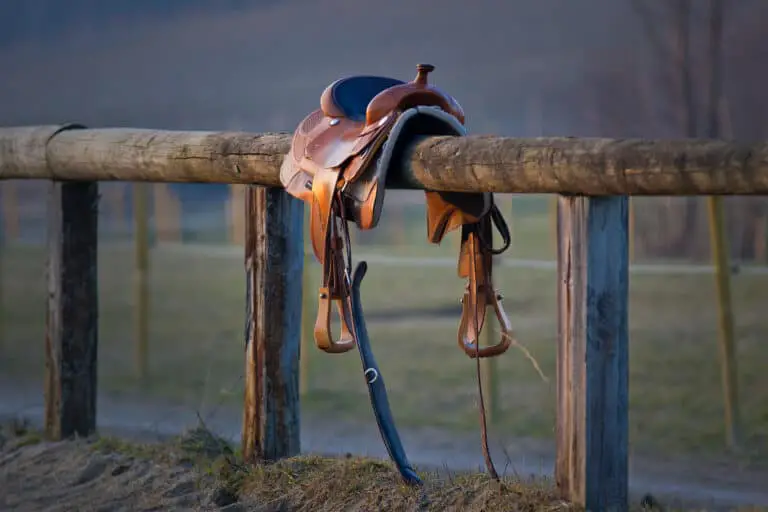Icelandic Horse Breed: Care, Cost & History (2024)
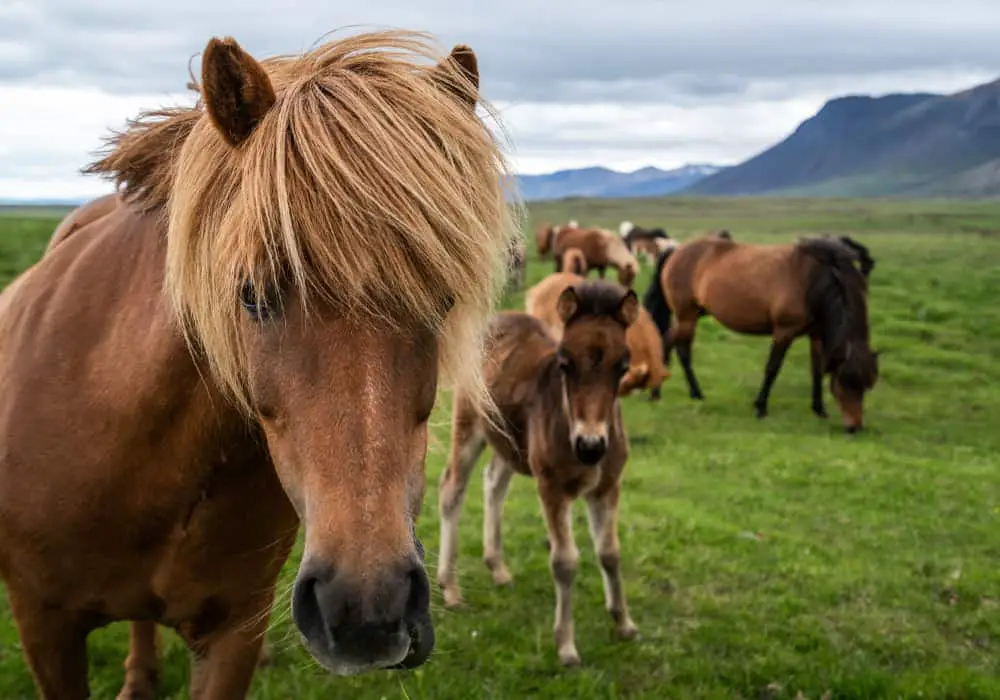
When one thinks about Iceland, horses often come to mind. The majestic creatures are well-respected animals in this country and Iceland allows only its very own breed of horses on their island – the Icelandic Horse.
The Icelandic breed is a proud ambassador for the beautiful country of Iceland and is considered as the horse of the Vikings – the Viking Horse.
They are famous for being the only breed in the world that can perform all five gaits with the Icelandic Horses tolt being the unique one to this breed.
Breed Profile
Breed: Icelandic Horse
Adult Weight: 730 and 840 lbs
Adult Height: 12.2 – 13.2 hands (50-54 inches)
Origin: Iceland
Use: Companionship, Riding, Breeding
Colors: Bay, Black, Chestnut, White, Silver dapple black, Blue Dun, Gray, Buckskin, Silver dapple blue roan, Silver dapple buckskin dun, Silver dapple bay dun – and many more
Features: Small Size, Short Legs, Full Mane and Tail
Lifespan: 20-30 Years
Character: Calm, Gentle, Friendly, and Intelligent
Gait: Icelandic Tolt, Sure-Footed, Steady
Best for: All Levels of Riders
Icelandic Horse Characteristics
The famous Icelandic horses have heavy manes and tails and come across as rather short-legged and sturdy. They appear as robust, yet elegant horses that defy the harsh weather of Iceland with their stocky, but beautiful bodies.
The Icelandic Horse is one of the purest breeds in the whole world. They often appear to be wild Icelandic Horses as they are frequently allowed to freely roam through the rugged landscapes of Iceland.
Size
The Icelandic breeding goal of their horse is a robust, fertile, and healthy horse that is durable for riding. Yet they should be versatile and elegant horses with five gaits (1). The Icelandic horse gait tolt is uniquely performed by this breed.
The Icelandic horse size can vary considerably, but the average Icelandic height as shown in breeding evaluation is now at approximately 52-56 inches (13-14 hands). The average height for the Icelandic horse mare is 53 inches (13 hands) and for the Icelandic horse gelding at 56 inches (14 hands).
The first Icelandic Horses came to Iceland with Viking settlers and have been isolated for over 1100 years, which is considered as one of the reasons for their relative height.
Weight
The Iceland mini horses weigh between 730 – 840 lbs. There is no significant difference in regards to the weight between the two sexes of this breed. The Icelandic Mares and Icelandic geldings weigh roughly about the same.
At first sight, the beautiful Icelandic Horse is often mistaken for a pony, due to its relative height, but these precious horses are in no way inferior to common horses – quite the opposite.
Due to their unique and sturdy bone density, they are able to safely carry tall adults and can do everything a horse can do. Even though the height of the Icelandic horse can sometimes be considered pony-size, they are not considered as an Icelandic Pony.
Colors
The Icelandic Horses are thought to be the most colorful diverse breed in the world. As one of the most colorful breeds on our planet, these horses show over 40 colors with up to 100 variants.
The Icelanders encourage variation in the Icelandic horse colors within the breed and all colors are allowed in the studbook.
The true roan – a color-changing coat – is the rarest color for Icelandic horses. The most common ones you will see are chestnut and black/brown.
It is interesting to know that all horses show one of the three basic colors – brown, chestnut or bay. Variations like dun, palomino, silver dapple, skewbald, gray, roan and splash-skewbald would come on top of these base colors. Further variations like the star, snip, blaze, white leg and much more can come on top of those.
Temperament
The Icelandic Horse temperament is one of the reasons why they won’t be considered a pony. Icelandic Horses are appraised as a perfect mixture of self-confidence and submissiveness, whilst still being gentle and easy-going with riders of all ages.
These horses thrive in groups with other horses and they are trustworthy and reliable when it comes to riding with their owners.
In fact, there are numerous reports about Icelandic Horses saving their riders during snowstorms – they will sometimes refuse to ride a certain way as they can sense a storm before the human rider can.
This breed is a true treasure for the whole family and will make a great and safe companion for kids and adults.
Icelandic Horse Care
A purebred Icelandic Horse is most likely used to harsh weather and adapted well to the circumstances of the elements.
In Iceland, they are the only domesticated animal that is often kept outdoors all year round and they tend to their nutrition by themselves as they will oftentimes graze what they need to be healthy and fat horses.
Diet and Nutrition
The Icelandic horse is thrifty when it comes to its diet and nutrition. A lot of Icelandics will get along just fine with grass and hay which is ideal nutrition for them.
Most probably you will not need any additional grain or very little at all.
As they are genetically used to the rich soils of Iceland one may want to add some vitamin-mineral supplements, like multivitamins (2), to their diet – if needed or advised by their vet.
It is recommendable not to overfeed them with starch, grain, or calorie-rich hay to prevent problems with obesity and their joints as they are a rather small equine (3).
Health Problems
The Icelandic horse breed is mostly considered healthy and sturdy. They are even said to have no genetic problems. Even though some studies have indicated that steady and balanced training throughout the year is important for their health.
It is common in Iceland for the horses to rest throughout the winter season and have their training and exercise concentrated in spring and summer – this might have an unfavorable effect on their heart rate and concentrations of lactic acid in their muscle tissue.
Another point to factor in is the weight of the rider. Even though the bone density of the Icelandic horse is strong, the rider should not be too heavy to not strain the back of those small equines too much (4).
Grooming
Icelandics should be groomed at least once a day by brushing them with a body brush. A curry comb can help you to remove dirt that is closer to the skin and cant be removed by the body brush.
Hoof picking can be done every 3-4 days with a hoof pick. This breed has a strong hoof wall and a thick sole which is inherent to their breed. Obviously, this is an evolutionary advantage that evolved due to the hard floors and the difficult and diverse footing in Iceland.
This is why many riders state that their Icelandics do well without shoes and a trim every 6-8 weeks is sufficient. This decision should be made in consideration of their environment and what they are used for.
Kept in a cold environment, most Icelandics will do just fine without coats and will be happy to have a sheltered barn in winter. The usual appointments of the dentist and veterinarian should be made to ensure your Icelandic stays as sturdy as it is (5).
Icelandic Horse History
The first Icelandic horses came to shore on Iceland with Viking settlers in the ninth century.
Considering that the first roads were built in the 1870s, Icelandic horses were the most important form of transportation and infrastructure in Iceland for many centuries.
The horses of Iceland are one of the purest breeds and the Icelandic Horse Head is sometimes portrayed on historical artifacts.
Origin
The Icelandic Horse’s history is one of the richest in equine documentation. The Icelandic horse origin lies with the Viking settlers who imported the first horses to Iceland about eleven centuries ago.
They came from Norway and the British Isles on the Vikings’ well-known boats. The Icelandic Horse is thought to be most likely genetically originated from German and Norwegian horses – at least this was determined when comparing the bone structures of those three breeds.
From about 1100 the import of any other horse breed has been forbidden to Iceland which is the reason for the pureness of Iceland’s wild horses.
Historic Development
Since the government in Iceland prohibited the import of any other horse breed, the Icelandic Horse became a desirable breed that is well-known for its pure genes.
The weather and circumstances of the rough exposure to the elements in Iceland is the reason why the Icelandic Horse breed has a thick mane and tail and can grow very thick double-coats.
Their hoof walls are very thick and this breed is almost unknown to diseases. Icelandics are a loved breed in many countries and they are exported regularly from Iceland.
Did you know that a horse that leaves Iceland is never allowed to return? Kind of tragic.
Notable Icelandic Horses
Since Icelandic Horses are THE symbol for Iceland, the breed has become a symbol for this wild and beautiful country.
You will see them in every documentation about Iceland for sure and oftentimes hear about them in news regarding Iceland. They even play a huge role in Norse Mythology.
Sleipnir – Odin’s Horse
Sleipnir is a famous horse in Norse Mythology. He is called the eight-footed pacer and – as the name indicates – he had eight feet. He was the steed of the Norse God Odin. Sleipnir is supposed to be of gray color and was able to ride in the sky, the water, and on land.
Andre Samplawski – TikTok Horse
You probably think this is a weird name for a horse – and you are right. Andre Samplawski is a human who became famous with his TikTok video where he pours water onto a toy horse which then seems to magically transform into a real Icelandic horse. He lives on an Icelandic Horse farm in Germany with 40 Icelandic Horses.
Kopar frá Sunnuhvoli
Kopar frá Sunnuhvoli is a beautiful Icelandic Horse that won the YR World Championship with the rider Elsa Teverud. They won the C5 five gait combination. Kopar frá Sunnuhvoli and Elsa were a famous team in Swedish Tournaments and won several national titles as well. Kopar was sold to a new owner recently.
Myths and Legends
There are a lot of Myths and Legends about Icelandic Horses. Almost every Norse God owned a precious steed of this breed.
The famous combination of Sleipnir and Odin is just one example of many. The horse Sleipnir could only be tamed by Odin as it has been told by Norse Mythology.
The Horses of the Æsir
The Horses of the Æsir is a poem that lists the horses of the Norse gods, who are called Æsir. The poem says the Norse Gods ride each day on their steeds and go to council with them which is located at Yggdrasil’s ash. The poem lists eleven horses and we do not know much about many of them.
Skinfaxi and Hrímfaxi
Skinfaxi and Hrímfaxi are the horses of Dagr, who represents the day, and Nótt, who is the Night. The names mean “shining mane” and “rime mane”, which could also be translated as “frost mane”. The Norse Mythology says that Skinfaxi pulls Dagr’s chariot across the sky every day. His mane is said to light up the sky and earth.
Grani
A Scandinavian heroic legend tells us that Grani is the horse owned by the Norse hero Sigurd. Sigurd receives Grani, who is the descendant of Sleipnir, Odin’s horse, through advice from the Norse God Odin. He meets an old man and asks him to help him choose a horse without knowing the old man is Odin himself.
Modern Icelandic Horses
Nowadays Icelandic Horses are an internationally loved and popular breed. Equestrians love the Icelandic horse behavior.
They are famous for being friendly and strong horses who can be used by the whole family. They are easy to care for and considered to be a healthy breed. They do not spook easily and can be used for almost every equine aspect.
Breeding
Even though many more than just Icelandic breeders breed Icelandic Horses, the locally-bred horses of Iceland are considered to be the purest of them all. You can purchase an Icelandic Horse in most countries nowadays and decide between many different Icelandic colors.
The rare roan is a popular wish amongst some riders, but as many more factors are important for the purchase of a horse, the more commonly chestnut color is also a popular choice.
The colorful variations of the Icelandic horse make every horse unique. Some well-known bloodlines of this breed are Kjarri, Gröf, Hóli, and Kjarnholtum. To breed an Icelandic with all five gaits – which is unique to this breed – is a big plus for any breeder and buyer.
Population
The Icelandic horse population in Iceland is very interesting. Iceland has just about 350,000 people living on this rather small island. Yet, Iceland is home to around 80,000 Icelandic Horses.
This gives us an indication of how important the Icelandic Horse is for the Icelanders. There is about one horse for four people. Internationally there are 180,000 total registered Icelandic Horses around the world.
Many of those international Icelandic Horses are living in Germany which is a “Hot Spot” for Icelandics as many riding clubs and breed societies have developed there. There are only about 4500 Icelandic Horses living in the United States.
Uses
The Use of the Icelandic Horse has been throughout history very versatile. In Iceland, horses are still used for agriculture and economical purposes, whilst the use of them for dressage and tournaments also became quite popular in international countries like Germany, Norway, and Sweden.
The common Icelandic Horse is mainly used for riding an Icelandic horse and is used as a family equine.
As the Icelandic Horse is the only horse that can perform five gaits, the famous Icelandic Horse tolt is a reason for many horse enthusiasts to get an Icelandic. The ability to perform five gaits makes the Icelandic a very comfortable horse to ride.
Icelandic Horse Prices
As you’ve probably read in the beginning, there are not too many Icelandic Horses roaming the world, compared to more common breeds.
The limitation of horses and Icelandic-versatile trainers makes the initial purchase a little bit more expensive compared to purchasing more common horse breeds. If you plan to purchase an Icelandic you should expect to pay about $10,000 (6).
Purchase Price
The Icelandic price of your precious steed is determined by several factors. The age of the horse and its training level are two major factors as you are literally paying for time – time the horse has been trained and time the horse has been cared for.
Even though an Icelandic Horse is not necessarily considered a super luxurious horse, the prices can vary from $5000 for a two-year-old mare up to $20,000 (7) for a four-year-old, trained Icelandic stallion.
The physical features of a horse – the Icelandic horse height and Icelandic horse weight for example – are another major factor for the price. If you want to purchase a horse from a renowned bloodline within the breed, you can expect to pay significantly more.
Ownership Costs
When it comes to costs there are a lot of different costs to factor in. Is your horse already trained for the intended use or will you have to pay for training?
Despite the initial cost of purchasing the horse ($10,000-$15,000), you can add on the monthly fees of hay, care and feeding, assuming that you don’t have a smallholding, which will be around 400-800$ in most countries.
Board
At least when it comes to boarding costs. Boarding is a major factor when it comes to the price of horsemanship.
Do you have a property or smallholding where the horse can live and graze for free or will you have to pay monthly fees for stable and care?
Keeping a horse near a big city will probably be more expensive – between $400-$600 each month – than in areas where there are a lot of equestrians already and boarding can only cost as much as $150-$200.
Feed
Since Icelandics are happy and healthy with grazing their grass and having a few snacks of hay, depending on hay prices in your region – which can vary from $2 to $15 a bale – you might have to pay for supplements if your horse is competing or racing in tournaments.
Vet Care
The annual cost of the vet caring for your horse will be approximately around $200-$300 if you have set up a yearly care plan.
These costs will cover the annual vaccinations, the deworming for 12 months, and teeth floating once or twice per year.
These costs do not cover anything unexpected like injuries, inflammations, or colics – all of them alone can easily cost you $500-$1200 depending on the severity of the problem.
Hoof Care
Luckily, a lot of Icelandic Horses do not need shoes which can be a relief for your pockets. As horses need to get new shoes or a trim every 6-8 weeks, the costs of hoof care can be considered a regular expense.
Trimming your horses’ hooves will most likely cost around $20-$35 every few weeks. Shoeing your horse will cost you more than twice as much – around $80.
This brings the costs to anything from $150 to over $1000 annually depending on the hoof and shoe care.
Buying an Icelandic Horse
Buying a horse is such a huge responsibility. It can be really frightening at first and you should really be 100% sure that you can tend to the horse as the horse deserves it.
Always make sure to meet your Icelandic before buying – even if you have to fly to Iceland. The horse should always come with all the documentation and health certificates.
Is the Icelandic Horse Right for You?
If you want to have a close relationship with your horse and want to go on regular treks, the Icelandic horse might just be the breed for you.
Even if you are not an advanced rider, this breed can be ridden smoothly and is forgiving and patient with beginners.
If you feel safe in the saddle, this breed is also great for going on rides through difficult terrain as they are very steady and don’t spook easily.
How to Buy an Icelandic Horse?
If you’ve made the decision to finally buy an Icelandic, you will first need to search for the Icelandic breeder of your trust.
Some people like to import Icelandic Horses directly from Iceland, but this comes with more costs and also with stress for the horse itself as it has to travel by plane or ship – and remember, they can never return.
You will want to buy from a breeder that is open with you and lets you handle and ride the horse.
Take a look at the farm and how the horses are treated – is the farm clean, do the horses look happy and healthy? Are the horses on the paddock or in their stables? What is the horse’s relationship with its current owner?
The seller should also ask you several questions to make sure the horse is sold into a good home.
Similar Breeds to Icelandic Horse
The relative height of the Icelandic Horse lets it often be mistaken for a pony, which some proud Icelanders regularly frown upon.
The thick coat and the full mane and tail of the Icelandic lets it also is confused with a few other breeds, who have a similar look to them. Let’s clear this up.
Faroe Pony of the Faeroe Islands
The height of the Faroe Pony and its thick coat and mane are this breed’s most similar features as to why they get often mistaken for an Icelandic Horse.
The breed is in fact smaller than the Icelandic Horse. It should be noted that the Faroe Pony is related to the Icelandic Pony, so there is no shame in mistaking them for each other.
Norwegian Fjord Horse
The Norwegian Fjord Horse is another small equine that is native to the coastal regions of Norway.
The small height and the sturdy body are the reasons why this breed is sometimes mixed up with the Icelandic Horse.
They can be easily separated from each other as all Fjord Horses are dun – a tan coat color – and their mane is oftentimes clipped short in a distinctive shape.
Northlands Horse
It comes as no big surprise that the Northlands Horse of Norway can be mistaken as an Icelandic Horse as they have a similar outer appearance and are most likely related.
Northlands Horses are the smallest of all Norwegian horse breeds and were used by the Vikings for their traveling.
FAQ
What is an Icelandic horse?
The Icelandic Horse is a small equine that originates from Iceland. It is one of the purest and most colorful breeds in the world and is considered a horse, even though it can be of pony size.
What does an Icelandic horse look like?
The Icelandic Horse is a rather small horse, that has short legs and a sturdy body. It is robustly built and has a full mane and tail.
How did the Icelandic horse get its name?
As the pride of Iceland, it was named after the country it originated from. It has been locally bred there for more than 1100 years and is the only breed allowed in the country.
Can you ride an Icelandic horse?
Icelandic Horses are great for horseback riding as they are very comfortable to ride and their strong bone density allows them to carry tall riders despite their short height.
Are Icelandic horses good for beginners?
A beginner will be very happy with an Icelandic Horse as they are considered very loyal and friendly horses who will protect their rider at all costs.
How tall is an Icelandic horse?
Icelandic Horses are rather small equine and have an approximate height of 4ft 8 (56 inches). They can still carry tall and adult riders due to their excellent bone density.
How much does an Icelandic horse weigh?
Icelandic Horses weigh between 730 – 840 lbs. There is no big difference in regards to the weight between the two sexes of this breed, yet stallions tend to be a little taller.
How big is an Icelandic horse?
Being of small height the Icelandic Horse offers a sturdy and robust body which allows the horse to be a comfortable companion for all riders.
How much does an Icelandic horse cost?
The price depends very much on many factors, but if you look to buy a relatively well-trained horse of a young to medium age and a good Icelandic Horse pedigree, you can estimate about $10,000 for the initial purchase.
How much does Icelandic horse ownership cost?
The costs of owning an Icelandic Horse do not differ much from owning a horse in general (roughly $350-$600/month), but the costs of hoof care and nutrition can be slightly less than usual as this breed is easily cared for.
How long do Icelandic horses live?
The Icelandic horse lifespan is between 20-30 years which is a common life span for many horse breeds. The better you care for your horse, the longer it might live.
How fast can an Icelandic horse run?
The Icelandic Horse Speed can be up to 30 miles (48 km/h) per hour. They are used in pacing races as they are fast and smooth horses.
How much can an Icelandic horse pull?
Icelandic Horses are strong and are used to pull carts in their home country Iceland. Their ability to carry should give an indication about how much they are qualified to pull.
How much can an Icelandic horse carry?
Icelandic Horses can carry up to a maximum of 35% of their own weight which is 282lbs (128 kg) on average. That’s not bad at all.
At what age is an Icelandic horse full grown?
Icelandic horse foals take quite a lot of their time to mature. They will not be fully grown until they reach six or seven years of age.
What are Icelandic horses used for?
Icelandic Horses are used for almost every equine activity there is. They are used for agriculture, riding, jumping, dressage, and many more fun activities.
References
- Oklahoma State University, Breeds of Livestock, Department of Animal Science. 2022. Breeds of Livestock – Icelandic Horse. Link
- Birta Ólafsdóttir, Ingibjörg Gunnarsdóttir, Hjálmfríður Nikulásdóttir, Guðný Eiríksdóttir, Tamara B. Harris, Lenore J. Launer, Vilmundur Guðnason, Thórhallur I. Halldórsson, Kristjana Einarsdóttir. 2017. Dietary supplement use in the older population of Iceland and association with mortality. Link
- Kentucky Equine Research. 2007. Icelandic Horses. Link
- ScienceNordic, Ingrid Hagerup. 2015. Icelandic horses carry heavy burdens. Link
- K. Hugason. 2003. Breeding of Icelandic toelter horses: an overview. Link
- Harmony Icelandics. 2017. Finding Your Perfect Icelandic Horse. Link
- Ehorses. 2022. Icelandic Horse for sale. Link

